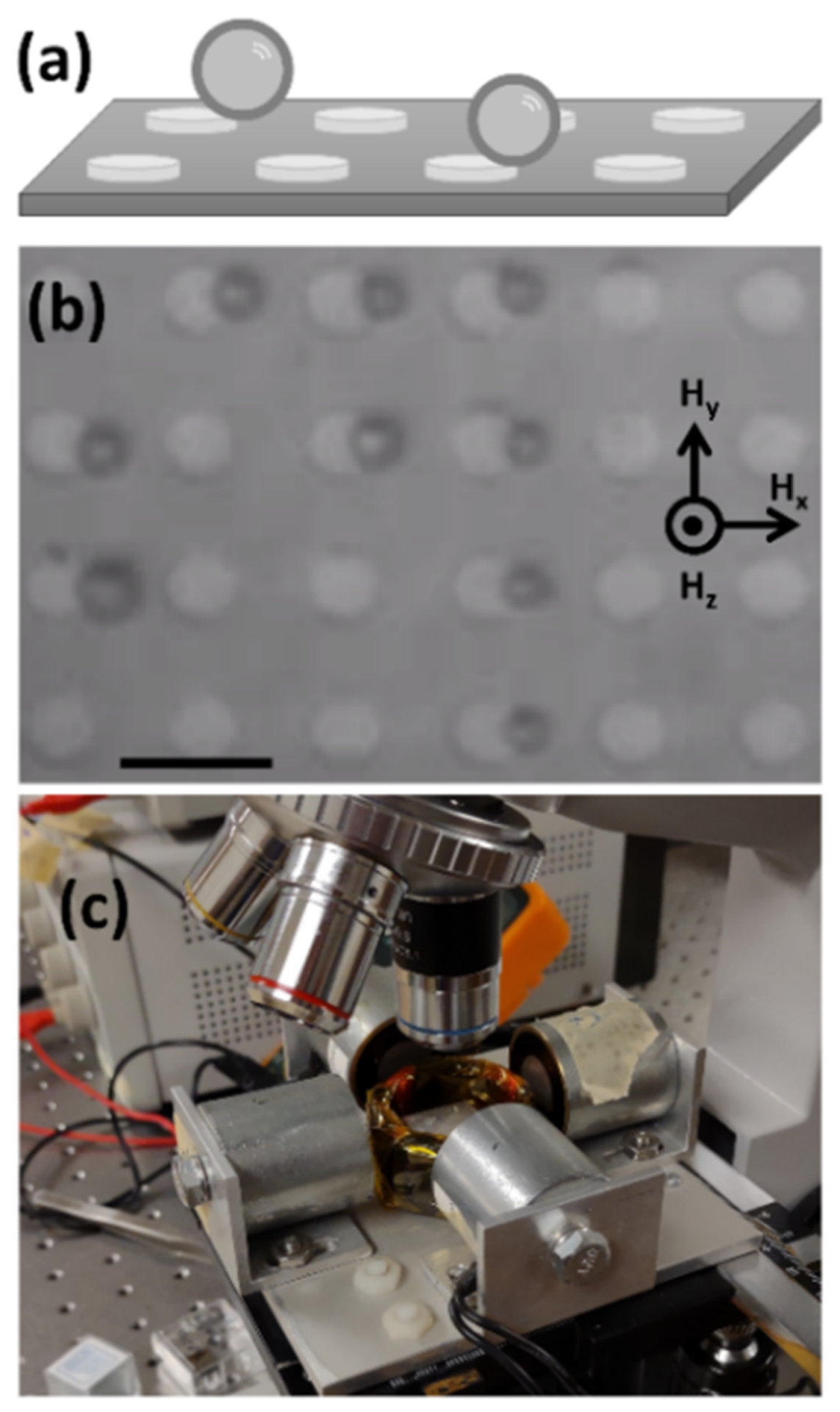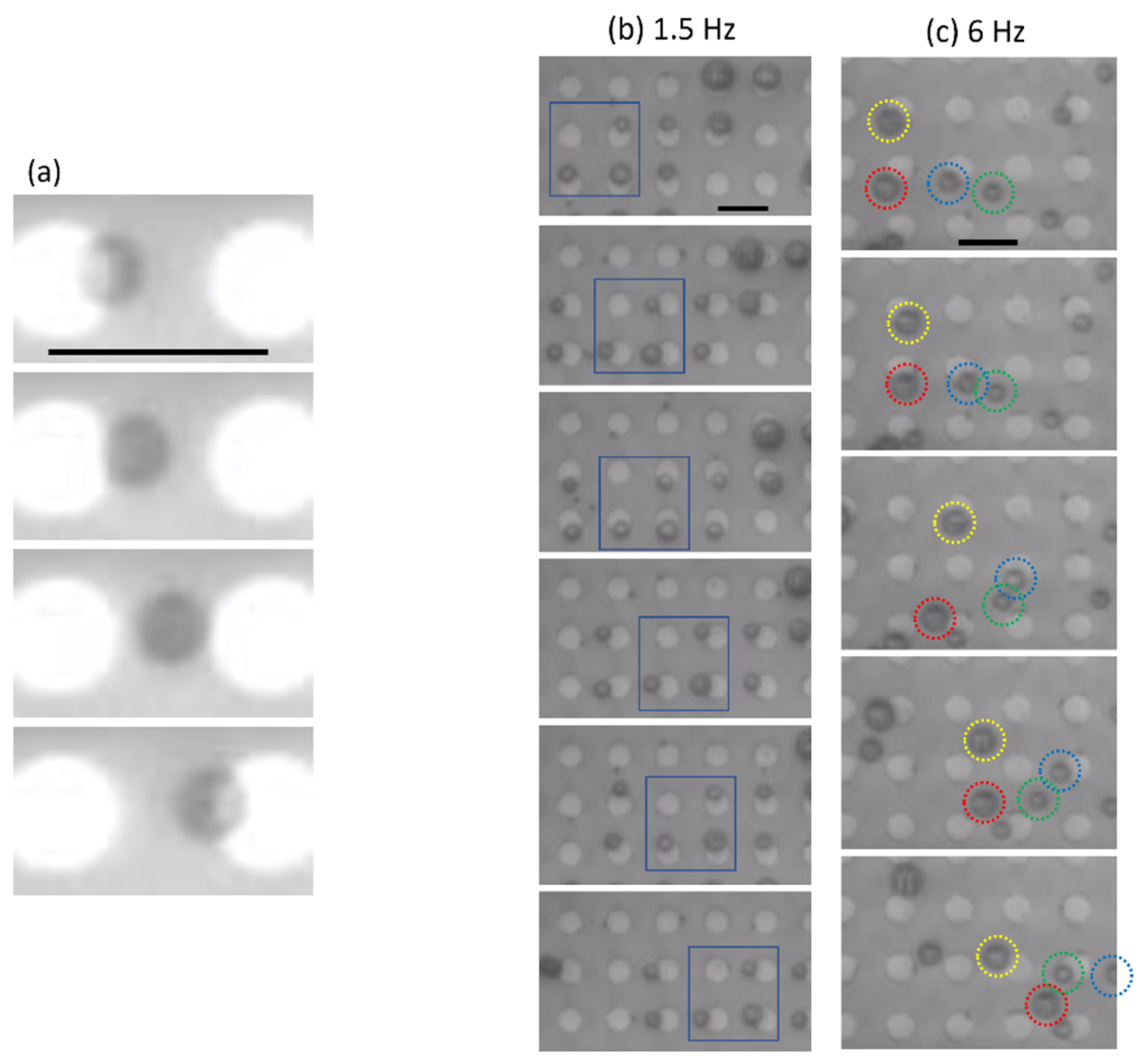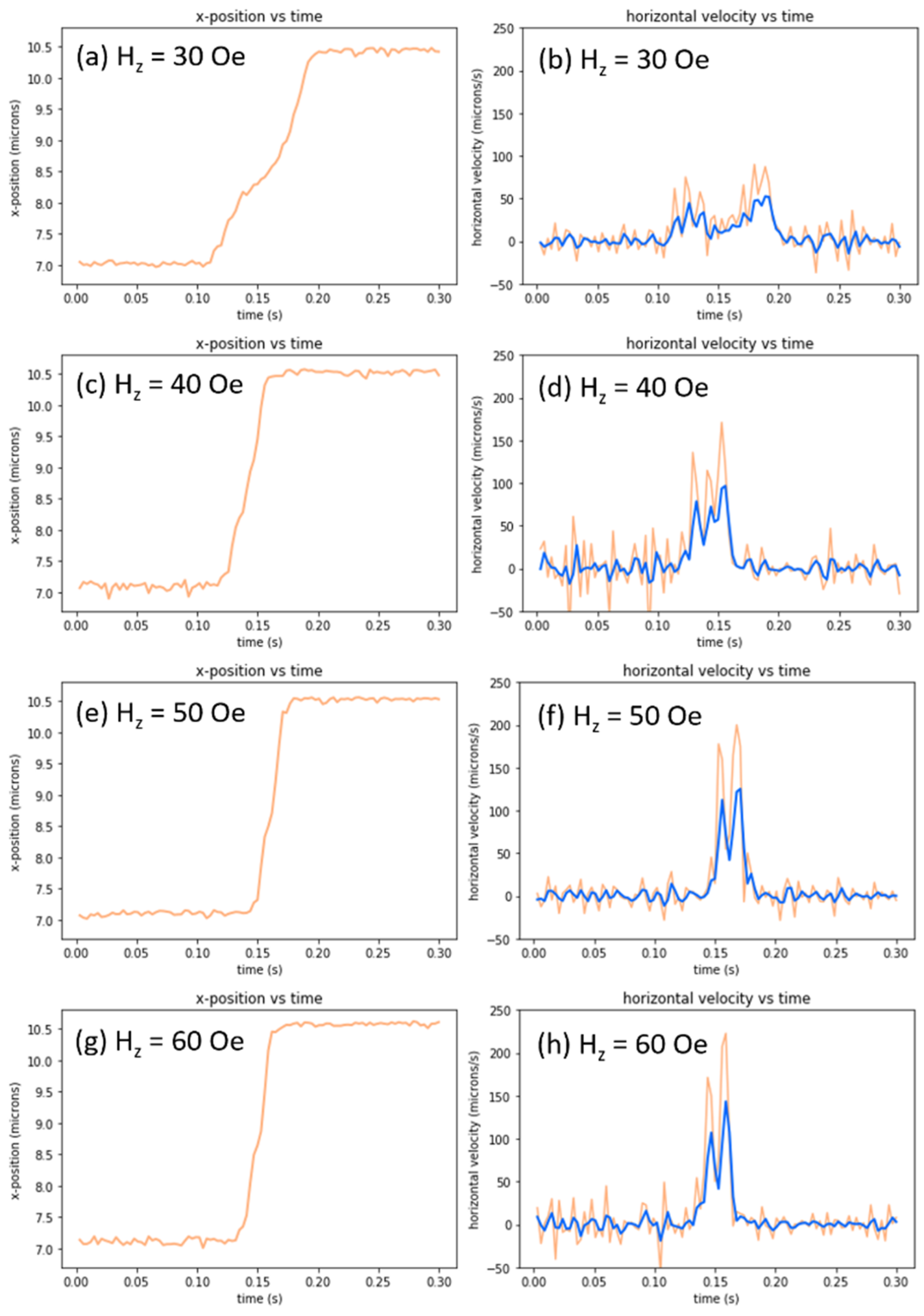Short- and Long-Range Microparticle Transport on Permalloy Disk Arrays in Time-Varying Magnetic Fields
Abstract
:1. Introduction
2. Results
2.1. Short Range
2.2. Long Range
3. Discussion
4. Materials and Methods
4.1. Device Preparation
4.2. Experimental Methods for Particle Manipulation
4.3. Particle Tracking Methods
4.4. Description of Simulation
Supplementary Materials
Author Contributions
Funding
Acknowledgments
Conflicts of Interest
References
- Zborowski, M.; Chalmers, J.J. Rare Cell Separation and Analysis by Magnetic Sorting. Anal. Chem. 2011, 83, 8050–8056. [Google Scholar] [CrossRef] [PubMed] [Green Version]
- Min, H.; Jo, S.-M.; Kim, H.-S. Efficient Capture and Simple Quantification of Circulating Tumor Cells Using Quantum Dots and Magnetic Beads. Small 2015, 11, 2536–2542. [Google Scholar] [CrossRef] [PubMed]
- Klein, S.; Müller, T.G.; Khalid, D.; Sonntag-Buck, V.; Heuser, A.-M.; Glass, B.; Meurer, M.; Morales, I.; Schillak, A.; Freistaedter, A.; et al. SARS-CoV-2 RNA Extraction Using Magnetic Beads for Rapid Large-Scale Testing by RT-QPCR and RT-LAMP. Viruses 2020, 12, 863. [Google Scholar] [CrossRef] [PubMed]
- Yellen, B.B.; Erb, R.M.; Son, H.S.; Rodward Hewlin, J.; Shang, H.; Lee, G.U. Traveling Wave Magnetophoresis for High Resolution Chip Based Separations. Lab Chip 2007, 7, 1681–1688. [Google Scholar] [CrossRef] [PubMed]
- Henighan, T.; Chen, A.; Vieira, G.; Hauser, A.J.; Yang, F.Y.; Chalmers, J.J.; Sooryakumar, R. Manipulation of Magnetically Labeled and Unlabeled Cells with Mobile Magnetic Traps. Biophys. J. 2010, 98, 412–417. [Google Scholar] [CrossRef] [PubMed] [Green Version]
- Hu, X.; Abedini-Nassab, R.; Lim, B.; Yang, Y.; Howdyshell, M.; Sooryakumar, R.; Yellen, B.B.; Kim, C. Dynamic Trajectory Analysis of Superparamagnetic Beads Driven by On-Chip Micromagnets. J. Appl. Phys. 2015, 118, 203904. [Google Scholar] [CrossRef] [PubMed] [Green Version]
- Li, P.; Gandhi, D.; Mutas, M.; Ran, Y.-F.; Carr, M.; Rampini, S.; Hall, W.; Lee, G.U. Direct Identification of the Herpes Simplex Virus UL27 Gene through Single Particle Manipulation and Optical Detection Using a Micromagnetic Array. Nanoscale 2020, 12, 3482–3490. [Google Scholar] [CrossRef] [PubMed]
- Vieira, G.; Henighan, T.; Chen, A.; Hauser, A.J.; Yang, F.Y.; Chalmers, J.J.; Sooryakumar, R. Magnetic Wire Traps and Programmable Manipulation of Biological Cells. Phys. Rev. Lett. 2009, 103, 128101. [Google Scholar] [CrossRef] [PubMed]
- Yellen, B.B.; Virgin, L.N. Nonlinear Dynamics of Superparamagnetic Beads in a Traveling Magnetic-Field Wave. Phys. Rev. E 2009, 80, 011402. [Google Scholar] [CrossRef] [PubMed]
- Pease, C.; Wijesinghe, H.S.; Etheridge, J.; Pierce, C.J.; Sooryakumar, R. Magnetic and Hydrodynamic Torques: Dynamics of Superparamagnetic Bead Doublets. J. Magn. Magn. Mater. 2018, 466, 323–332. [Google Scholar] [CrossRef]
- Sajjad, U.; Holländer, R.B.; Klingbeil, F.; McCord, J. Magnetomechanics of Superparamagnetic Beads on a Magnetic Merry-Go-Round: From Micromagnetics to Radial Looping. J. Phys. D Appl. Phys. 2017, 50, 135003. [Google Scholar] [CrossRef]
- Klingbeil, F.; Block, F.; Sajjad, U.; Holländer, R.B.; Deshpande, S.; McCord, J. Evaluating and Forecasting Movement Patterns of Magnetically Driven Microbeads in Complex Geometries. Sci. Rep. 2020, 10, 8761. [Google Scholar] [CrossRef] [PubMed]
- Rampini, S.; Li, P.; Gandhi, D.; Mutas, M.; Ran, Y.F.; Carr, M.; Lee, G.U. Design of Micromagnetic Arrays for On-Chip Separation of Superparamagnetic Bead Aggregates and Detection of a Model Protein and Double-Stranded DNA Analytes. Sci. Rep. 2021, 11, 5302. [Google Scholar] [CrossRef] [PubMed]
- Dynabeads Nucleic Acid Purification Support—Getting Started—US. Available online: //www.thermofisher.com/us/en/home/technical-resources/technical-reference-library/nucleic-acid-purification-analysis-support-center/dynabeads-nucleic-acid-purification-support/dynabeads-nucleic-acid-purification-support-getting-started.html (accessed on 19 June 2021).
- Email Communication with Spherotech Technical Specialist. Available online: https://www.spherotech.com/ (accessed on 19 October 2020).
- Prikockis, M.; Chen, A.; Byvank, T.; Vieira, G.B.; Peters, B.; Yang, F.; Sooryakumar, R. Programmable Self-Assembly, Disassembly, Transport, and Reconstruction of Ordered Planar Magnetic Micro-Constructs. IEEE Trans. Magn. 2014, 50, 1–6. [Google Scholar] [CrossRef]
- Henighan, T.; Giglio, D.; Chen, A.; Vieira, G.; Sooryakumar, R. Patterned Magnetic Traps for Magnetophoretic Assembly and Actuation of Microrotor Pumps. Appl. Phys. Lett. 2011, 98, 103505. [Google Scholar] [CrossRef] [Green Version]
- Tinevez, J.-Y.; Perry, N.; Schindelin, J.; Hoopes, G.M.; Reynolds, G.D.; Laplantine, E.; Bednarek, S.Y.; Shorte, S.L.; Eliceiri, K.W. TrackMate: An Open and Extensible Platform for Single-Particle Tracking. Methods 2017, 115, 80–90. [Google Scholar] [CrossRef] [PubMed]
- Schneider, C.A.; Rasband, W.S.; Eliceiri, K.W. NIH Image to ImageJ: 25 Years of Image Analysis. Nat. Methods 2012, 9, 671–675. [Google Scholar] [CrossRef]
- Li, P.; Kilinc, D.; Ran, Y.-F.; Lee, G.U. Flow Enhanced Non-Linear Magnetophoretic Separation of Beads Based on Magnetic Susceptibility. Lab Chip 2013, 13, 4400–4408. [Google Scholar] [CrossRef] [PubMed] [Green Version]
- Hu, X.; Goudu, S.R.; Torati, S.R.; Lim, B.; Kim, K.; Kim, C. An On-Chip Micromagnet Frictionometer Based on Magnetically Driven Colloids for Nano-Bio Interfaces. Lab Chip 2016, 16, 3485–3492. [Google Scholar] [CrossRef]
- Hu, X.; Torati, S.R.; Yoon, J.; Lim, B.; Kim, K.; Kim, C. Magnetically Characterized Molecular Lubrication between Biofunctionalized Surfaces. ACS Appl. Mater. Interfaces 2018, 10, 16177–16182. [Google Scholar] [CrossRef] [PubMed]





Publisher’s Note: MDPI stays neutral with regard to jurisdictional claims in published maps and institutional affiliations. |
© 2021 by the authors. Licensee MDPI, Basel, Switzerland. This article is an open access article distributed under the terms and conditions of the Creative Commons Attribution (CC BY) license (https://creativecommons.org/licenses/by/4.0/).
Share and Cite
Vieira, G.B.; Howard, E.; Hoang, D.; Simms, R.; Raymond, D.A.; Cullom, E.T. Short- and Long-Range Microparticle Transport on Permalloy Disk Arrays in Time-Varying Magnetic Fields. Magnetochemistry 2021, 7, 120. https://doi.org/10.3390/magnetochemistry7080120
Vieira GB, Howard E, Hoang D, Simms R, Raymond DA, Cullom ET. Short- and Long-Range Microparticle Transport on Permalloy Disk Arrays in Time-Varying Magnetic Fields. Magnetochemistry. 2021; 7(8):120. https://doi.org/10.3390/magnetochemistry7080120
Chicago/Turabian StyleVieira, Gregory Butler, Eliza Howard, Dung Hoang, Ryan Simms, David Alden Raymond, and Edward Thomas Cullom. 2021. "Short- and Long-Range Microparticle Transport on Permalloy Disk Arrays in Time-Varying Magnetic Fields" Magnetochemistry 7, no. 8: 120. https://doi.org/10.3390/magnetochemistry7080120
APA StyleVieira, G. B., Howard, E., Hoang, D., Simms, R., Raymond, D. A., & Cullom, E. T. (2021). Short- and Long-Range Microparticle Transport on Permalloy Disk Arrays in Time-Varying Magnetic Fields. Magnetochemistry, 7(8), 120. https://doi.org/10.3390/magnetochemistry7080120





